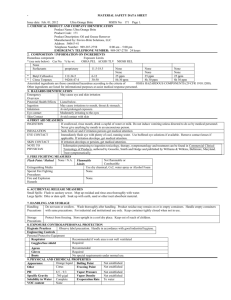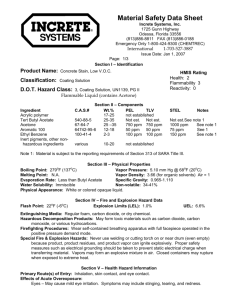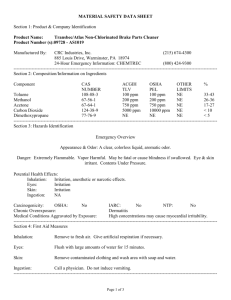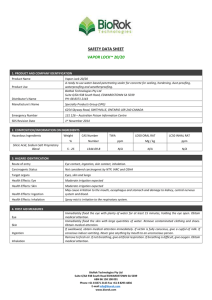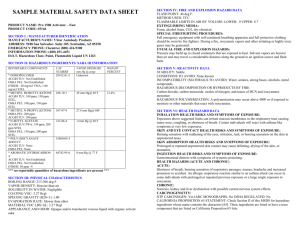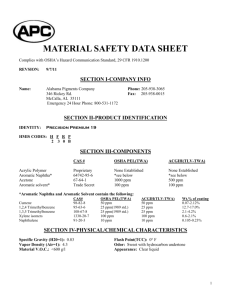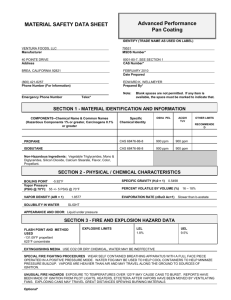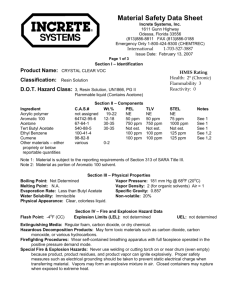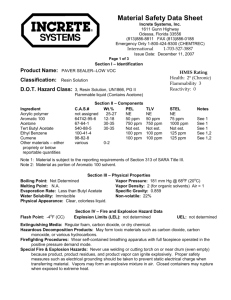section 2 – composition, information & ingredients - Weld-Aid
advertisement
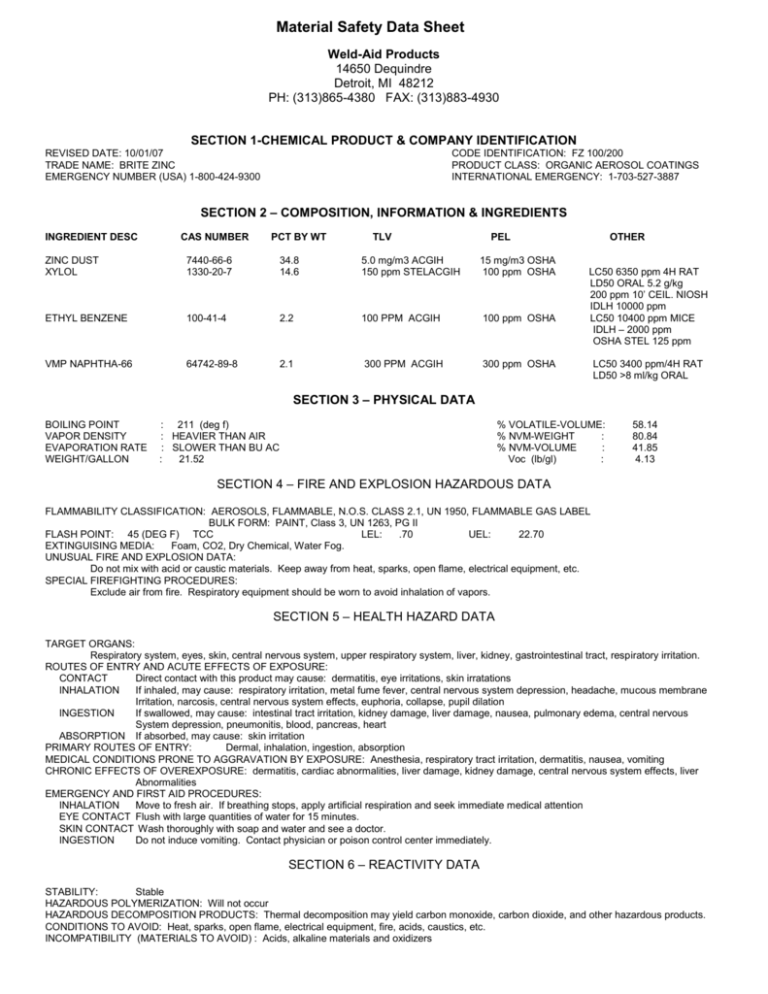
Material Safety Data Sheet Weld-Aid Products 14650 Dequindre Detroit, MI 48212 PH: (313)865-4380 FAX: (313)883-4930 SECTION 1-CHEMICAL PRODUCT & COMPANY IDENTIFICATION REVISED DATE: 10/01/07 TRADE NAME: BRITE ZINC EMERGENCY NUMBER (USA) 1-800-424-9300 CODE IDENTIFICATION: FZ 100/200 PRODUCT CLASS: ORGANIC AEROSOL COATINGS INTERNATIONAL EMERGENCY: 1-703-527-3887 SECTION 2 – COMPOSITION, INFORMATION & INGREDIENTS INGREDIENT DESC CAS NUMBER PCT BY WT TLV PEL ZINC DUST XYLOL 7440-66-6 1330-20-7 34.8 14.6 5.0 mg/m3 ACGIH 150 ppm STELACGIH 15 mg/m3 OSHA 100 ppm OSHA ETHYL BENZENE 100-41-4 2.2 100 PPM ACGIH 100 ppm OSHA VMP NAPHTHA-66 64742-89-8 2.1 300 PPM ACGIH 300 ppm OSHA OTHER LC50 6350 ppm 4H RAT LD50 ORAL 5.2 g/kg 200 ppm 10’ CEIL. NIOSH IDLH 10000 ppm LC50 10400 ppm MICE IDLH – 2000 ppm OSHA STEL 125 ppm LC50 3400 ppm/4H RAT LD50 >8 ml/kg ORAL SECTION 3 – PHYSICAL DATA BOILING POINT VAPOR DENSITY EVAPORATION RATE WEIGHT/GALLON : 211 (deg f) : HEAVIER THAN AIR : SLOWER THAN BU AC : 21.52 % VOLATILE-VOLUME: % NVM-WEIGHT : % NVM-VOLUME : Voc (lb/gl) : 58.14 80.84 41.85 4.13 SECTION 4 – FIRE AND EXPLOSION HAZARDOUS DATA FLAMMABILITY CLASSIFICATION: AEROSOLS, FLAMMABLE, N.O.S. CLASS 2.1, UN 1950, FLAMMABLE GAS LABEL BULK FORM: PAINT, Class 3, UN 1263, PG II FLASH POINT: 45 (DEG F) TCC LEL: .70 UEL: 22.70 EXTINGUISING MEDIA: Foam, CO2, Dry Chemical, Water Fog. UNUSUAL FIRE AND EXPLOSION DATA: Do not mix with acid or caustic materials. Keep away from heat, sparks, open flame, electrical equipment, etc. SPECIAL FIREFIGHTING PROCEDURES: Exclude air from fire. Respiratory equipment should be worn to avoid inhalation of vapors. SECTION 5 – HEALTH HAZARD DATA TARGET ORGANS: Respiratory system, eyes, skin, central nervous system, upper respiratory system, liver, kidney, gastrointestinal tract, respiratory irritation. ROUTES OF ENTRY AND ACUTE EFFECTS OF EXPOSURE: CONTACT Direct contact with this product may cause: dermatitis, eye irritations, skin irratations INHALATION If inhaled, may cause: respiratory irritation, metal fume fever, central nervous system depression, headache, mucous membrane Irritation, narcosis, central nervous system effects, euphoria, collapse, pupil dilation INGESTION If swallowed, may cause: intestinal tract irritation, kidney damage, liver damage, nausea, pulmonary edema, central nervous System depression, pneumonitis, blood, pancreas, heart ABSORPTION If absorbed, may cause: skin irritation PRIMARY ROUTES OF ENTRY: Dermal, inhalation, ingestion, absorption MEDICAL CONDITIONS PRONE TO AGGRAVATION BY EXPOSURE: Anesthesia, respiratory tract irritation, dermatitis, nausea, vomiting CHRONIC EFFECTS OF OVEREXPOSURE: dermatitis, cardiac abnormalities, liver damage, kidney damage, central nervous system effects, liver Abnormalities EMERGENCY AND FIRST AID PROCEDURES: INHALATION Move to fresh air. If breathing stops, apply artificial respiration and seek immediate medical attention EYE CONTACT Flush with large quantities of water for 15 minutes. SKIN CONTACT Wash thoroughly with soap and water and see a doctor. INGESTION Do not induce vomiting. Contact physician or poison control center immediately. SECTION 6 – REACTIVITY DATA STABILITY: Stable HAZARDOUS POLYMERIZATION: Will not occur HAZARDOUS DECOMPOSITION PRODUCTS: Thermal decomposition may yield carbon monoxide, carbon dioxide, and other hazardous products. CONDITIONS TO AVOID: Heat, sparks, open flame, electrical equipment, fire, acids, caustics, etc. INCOMPATIBILITY (MATERIALS TO AVOID) : Acids, alkaline materials and oxidizers SECTION 7 – SPILL OR LEAK PROCEDURES STEPS TO BE TAKEN IN CASE MATERIAL IS RELEASED OR SPILLED: Remove all sources of ignition (heat, sparks, open flame). Avoid breathing Vapors. Ventilate area. Contain and clean up sills with non sparking tools, rags, etc. Use inert absorbent materials on small spills or Residuals of large spills. WASTE DISPOSAL METHOD: Dispose of in accordance with local, state, and federal regulations. SECTION 8 – SAFE HANDLING AND USE INFORMATION RESPIRATORY PROTECTION: Provide NIOSH/MSHA approved organic vapor canister respirators where oxygen content is adequate and where Airborne mists and vapor concentrations are above the time-weighted threshold limit values. When using in poorly ventilated and confined Spaces, use a fresh air supply respirator or a self-contained breathing apparatus. VENTILATION: Mechanical ventilation or local exhaust must be used to keep vapor concentrations below TLV. All ventilation equipment must be Explosion proof. PROTECTIVE GLOVES: Impermeable chemical handling gloves for skin protection. EYE PROTECTION: Use chemical safety glasses with side shields, goggles, and facefshields OTHER PROTECTIVE EQUIPMENT: Use impermeable aprons and protective clothing whenever possible to prevent skin contact. The use of Headcaps wherever possible is recommended. HYGIENIC PRACTICES: Eye bath and safety shower recommended SECTION 9 – SPECIAL PRECAUTIONS PRECAUTIONS TO BE TAKEN IN HANDLING AND STORING: Use non-sparking tools when handling this material. Avoid hot surfaces. Use in cool, Well-ventilated areas. Keep containers closed when not in use. Keep away from excessive heat and open flames. Avoid prolonged or repeated contact with the skin. Normally accepted grounding techniques are to be employed during all phases of handling and application. OTHER PRECAUTIONS: No smoking in areas where this material is used. Plastic utensils should not be used. Do not weld or flame cut on an “empty Drum”. Keep containers closed and upright when not in use. If the painted surface is to be welded, use a fan across the work area to prevent Fumes from rising to the welder’s face. Pump air into welder’s hood to provide positive air pressure to prevent fumes from getting to welder. Maintain good personal hygiene and plant housekeeping. This coating may contain materials classified as nuisance particulates which may be present at hazardous levels only during sanding or abrading of the Dried film. SECTION 10 – OTHER INFORMATION SECTION 313 SUPPLIER NOTIFICATION: This product contains the following toxic chemicals subject to the repoting requirements of section 313 Of the Emergency planning and Community Right-To-Know Act of 1985 and of 40 CFR 372: CHEMICAL NAME ZINC DUST ETHYL BENZENE XYLOL CAS NUMBER 7440-66-6 100-41-4 1330-20-7 PCT BY WT 34.85 2.26 14.64 DISCLAIMER OF LIABILITY The information in this MSDS was obtained from sources we believe are reliable. HOWEVER, THE INFORMATION IS PROVIDED WITHOUT ANY REPRESENTATION OR WARRANTY, EXPRESSED OR IMPLIED, REGARDING ITS ACCURACY OR CORRECTNESS. The conditions or methods of handling, storage, use, and disposal of the product are beyond our control and may be beyond our knowledge. FOR THIS AND OTHER REASONS, WE DO NOT ASSUME RESPONSIBILITY AND EXPRESSLY DISCLAIM LIABILITY FOR LOSS, DAMAGE, OR EXPENSE ARISING OUT OF OR IN ANY WAY CONNECTED WITH THE HANDLING, STORAGE, USE OR DISPOSAL OF THE PRODUCT.
